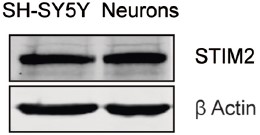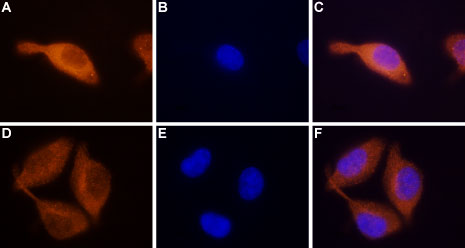Overview
|
Anti-STIM2 Antibody (#ACC-064) is a highly specific antibody directed against an epitope of the mouse protein. The antibody can be used in western blot, immunocytochemistry, and immunohistochemistry applications. It has been designed to recognize STIM2 from human, rat, and mouse samples.
Application key:
Species reactivity key:

Expression of STIM2 in mouse cortical neurons and human SH-SY5Y cells.Western blot analysis of mouse cortical neuron lysates and human SH-SY5Y cell lysates using Anti-STIM2 Antibody (#ACC-064). Actin is used as a loading control.Adapted from Gonzalez-Sanchez, P. et al. (2017) Front. Cell. Neurosci. 11, 363. with permission of Frontiers.
Applications
 Western blot analysis of rat brain (lanes 1, 3) and rat RBL basophilic leukemia cell (lanes 2, 4) lysates:1. Anti-STIM2 Antibody (#ACC-064), (1:200).
Western blot analysis of rat brain (lanes 1, 3) and rat RBL basophilic leukemia cell (lanes 2, 4) lysates:1. Anti-STIM2 Antibody (#ACC-064), (1:200).
2. Anti-STIM2 Antibody, preincubated with STIM2 Blocking Peptide (#BLP-CC064).
 Expression of STIM2 in rat lungImmunohistochemical staining of paraffin embedded rat lung sections using Anti-STIM2 Antibody (#ACC-064), (1:100). Staining is present in the respiratory epithelium of the bronchiole (red) as well as in the pneumonocytes of the alveolar wall (blue). Color reaction was obtained with SuperPicture HRP-conjugated polymer (Zymed) followed by DAB. Hematoxilin is used as the counterstain.
Expression of STIM2 in rat lungImmunohistochemical staining of paraffin embedded rat lung sections using Anti-STIM2 Antibody (#ACC-064), (1:100). Staining is present in the respiratory epithelium of the bronchiole (red) as well as in the pneumonocytes of the alveolar wall (blue). Color reaction was obtained with SuperPicture HRP-conjugated polymer (Zymed) followed by DAB. Hematoxilin is used as the counterstain. Stromal interaction molecule 2 (STIM2) in rat subventricular zone (SVZ) regionFree-floating frozen brain sections from a paraformaldehyde-perfused rat were incubated with rabbit anti-STIM2 antibody (#ACC-064, 1:300), followed by goat anti-rabbit secondary antibody conjugated to Alexa Fluor® 488 (green). A. STIM2 immunoreactivity was observed in the SVZ region (arrows). B. Pre-incubation of the primary antibody with the STIM2 Blocking Peptide (#BLP-CC064) suppressed the staining. Nuclear staining with DAPI (blue). LV = lateral ventricle.
Stromal interaction molecule 2 (STIM2) in rat subventricular zone (SVZ) regionFree-floating frozen brain sections from a paraformaldehyde-perfused rat were incubated with rabbit anti-STIM2 antibody (#ACC-064, 1:300), followed by goat anti-rabbit secondary antibody conjugated to Alexa Fluor® 488 (green). A. STIM2 immunoreactivity was observed in the SVZ region (arrows). B. Pre-incubation of the primary antibody with the STIM2 Blocking Peptide (#BLP-CC064) suppressed the staining. Nuclear staining with DAPI (blue). LV = lateral ventricle. Stromal interaction molecule 2 (STIM2) in rat medial septum (MS) regionFree-floating frozen brain sections from a paraformaldehyde-perfused rat were incubated with rabbit anti-STIM2 antibody (#ACC-064, 1:300), followed by goat anti-rabbit secondary antibody conjugated to Alexa Fluor® 488 (green). A. STIM2 immunoreactivity was observed in the medial septum region (arrows). B. Pre-incubation of the primary antibody with the STIM2 Blocking Peptide (#BLP-CC064) suppressed the staining. Nuclear staining with DAPI (blue).
Stromal interaction molecule 2 (STIM2) in rat medial septum (MS) regionFree-floating frozen brain sections from a paraformaldehyde-perfused rat were incubated with rabbit anti-STIM2 antibody (#ACC-064, 1:300), followed by goat anti-rabbit secondary antibody conjugated to Alexa Fluor® 488 (green). A. STIM2 immunoreactivity was observed in the medial septum region (arrows). B. Pre-incubation of the primary antibody with the STIM2 Blocking Peptide (#BLP-CC064) suppressed the staining. Nuclear staining with DAPI (blue). Stromal interaction molecule 2 (STIM2) in mouse nucleus basalis (NBM) regionFree-floating frozen brain sections from a paraformaldehyde-perfused mouse were incubated with rabbit anti-STIM2 antibody (#ACC-064, 1:300), followed by goat anti-rabbit secondary antibody conjugated to Alexa Fluor® 488 (green). A. STIM2 immunoreactivity was observed in the NBM region (arrows). B. Pre-incubation of the primary antibody with the STIM2 Blocking Peptide (#BLP-CC064) suppressed the staining. Nuclear staining with DAPI (blue).
Stromal interaction molecule 2 (STIM2) in mouse nucleus basalis (NBM) regionFree-floating frozen brain sections from a paraformaldehyde-perfused mouse were incubated with rabbit anti-STIM2 antibody (#ACC-064, 1:300), followed by goat anti-rabbit secondary antibody conjugated to Alexa Fluor® 488 (green). A. STIM2 immunoreactivity was observed in the NBM region (arrows). B. Pre-incubation of the primary antibody with the STIM2 Blocking Peptide (#BLP-CC064) suppressed the staining. Nuclear staining with DAPI (blue).
 Expression of STIM2 in RBL cellsImmunocytochemical staining of paraformaldehyde-fixed and permeabilized rat basophilic leukemia (RBL) cells.
Expression of STIM2 in RBL cellsImmunocytochemical staining of paraformaldehyde-fixed and permeabilized rat basophilic leukemia (RBL) cells.
A,D. Cells stained with Anti-STIM2 Antibody (#ACC-064), (1:100) followed by goat anti-rabbit-AlexaFluor-555 secondary antibody.
B,E. Nuclear staining of cells using the cell-permeable dye Hoechst 33342.
C. Merged image of panels A and B
F. Merged image of panels D and E.
Citations (6)
- Western blot of rat primary neurons. Tested in cells transfected with STIM2 shRNA.
Serwach, K. et al. (2023) Cell. Mol. Life Sci. 80, 368.
- Mouse cortical neuron lysates and human SH-SY5Y cell lysates.
Gonzalez-Sanchez, P. et al. (2017) Front. Cell. Neurosci. 11, 363. - Rat neonatal ventricular cardiomyocytes (1:200).
Sabourin, J. et al. (2016) J. Biol. Chem. 291, 13394. - Rat cortical neuron cell lysate.
Gruszczynska-Biegala, J. et al. (2011) PLoS ONE 6, e19285.
- Mouse brain sections (1:500).
Kikuta, S. et al. (2019) Front. Cell. Neurosci. 13, 547.
- Mouse brain sections (1:500).
Kikuta, S. et al. (2019) Front. Cell. Neurosci. 13, 547.
Specifications
- Peptide SAEKQWEVPDTASEC, corresponding to amino acid residues 583-597 of human STIM2 (Accession Q9P246). Intracellular, C-terminus.

Scientific Background
Cytosolic Ca2+ has long been known to act as a key second messenger in many intracellular pathways including synaptic transmission, muscle contraction, hormonal secretion, cell growth and proliferation.1,2 The mechanism controlling the influx of intracellular Ca2+ either by calcium-release-activated Ca2+ channels (CRAC) or from intracellular stores has lately become the focus of intense research.
Recently, several key players of the store-operated complex have been identified: the Orai family consists of three members: Orai1-3, and the STIM family, which consists of two members, STIM1 and STIM2.3 Orai1 (also known as CRACM1) acts as the store-operated calcium channel (SOC) and STIM1 as the endoplasmic reticulum (ER) Ca2+ sensor.3,4
While STIM1 appears to be localized intracellularly at the ER membrane and at a much lower extent on the cell surface of several cell types, STIM2 appears to be localized solely at the ER membrane.5 The function of STIM2 still remains elusive and several models have been suggested.6-8
- Eisner, D.A. et al. (2005) Exp. Physiol. 90, 3.
- Chakrabarti, R. and Chakrabarti, R. (2006) J. Cell. Biochem. 99, 1503.
- Feske, S. et al. (2006) Nature 441, 179.
- Pickett, J. (2006) Nat. Rev. Mol. Cell Biol. 7, 794.
- Dziadek, M.A. and Johnstone, L.S. (2007) Cell Calcium 42, 123.
- Parvez, S. et al. (2007) FASEB J. 22, 752.
- Brandman, O. et al. (2007) Cell 131, 1327.
- Soboloff, J. et al. (2006) Curr. Biol. 16, 1465.
